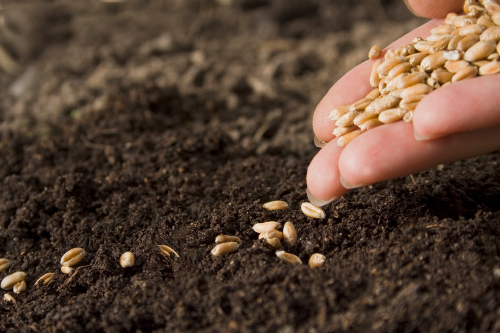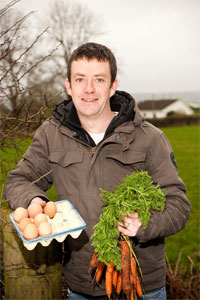Grow it Yourself - July
 I am growing scorzonera for the first time this year and enjoying the sight of it in the summer veg patch while waiting patiently to try it later in the autumn. This oddly named vegetable is relatively unknown in Ireland, but it is one that is well worth growing. It is grown for it’s long brown/black slender roots which are similar in taste to artichokes, and (to a lesser extent) for its spring shoots which are like asparagus.
I am growing scorzonera for the first time this year and enjoying the sight of it in the summer veg patch while waiting patiently to try it later in the autumn. This oddly named vegetable is relatively unknown in Ireland, but it is one that is well worth growing. It is grown for it’s long brown/black slender roots which are similar in taste to artichokes, and (to a lesser extent) for its spring shoots which are like asparagus.
Scorzonera needs a light, friable and sandy soil to grow well – it should never be grown in manured soil as (like carrots) it will fork. It is sown in late April or May in a well-prepared seed bed in rows 30cm apart and about 5cm deep in a drill. The seeds are large and easy to handle – you can sow two or three seeds every 10cm, and then remove the weaker seedlings leaving one at each 10cm interval. Once they have germinated there is very little work required – keep the bed weed free and water in very dry weather.
 The roots can be harvested from October but allow them to experience a frost or two to sweeten them up. The flowers are also edible. The roots are notoriously difficult to harvest without snapping, so it might be effective to grow the roots in pots for easy harvesting. Some roots can be left to overwinter (with foliage removed) – the new spring growth the following year is asparagus-like in taste.
The roots can be harvested from October but allow them to experience a frost or two to sweeten them up. The flowers are also edible. The roots are notoriously difficult to harvest without snapping, so it might be effective to grow the roots in pots for easy harvesting. Some roots can be left to overwinter (with foliage removed) – the new spring growth the following year is asparagus-like in taste.
The key when cooking is to remove the skins after boiling – otherwise preparing them can be cumbersome. Clean the roots and cut in to short lengths and boil in salted water for 25 minutes. Drain and then rub off the skins. Toss in a little melted butter.
Things to do this Month – July
To-Do
Any ground that has finished cropping must be quickly cleared away to take more vegetables. Use your produce - eat it, freeze it, process it, exchange it, give it away. Continue to water and feed plants and practice good weed control. Earth up brassicas such as Brussels sprouts - these plants will grow tall and require a good deal of support. Net plants to keep butterflies and the cabbage moth away.
Cut down legume plants that have finished cropping - leave the roots in the soil as they fix nitrogen in the soil. Give pumpkins plenty of water and apply a high-potash liquid feed.
Sow
Continue successional sowings and use quick maturing varieties for autumn use - Swiss chard, lettuce, rocket, salad onions, radish, turnips, peas, French Beans (dwarf), carrots. Sow for winter use - spring cabbage, Hungry Gap kale, parsley, perpetual spinach, chicory and coriander. Plant strawberries now for a good crop next June. Propagate rosemary, sage and mint from cuttings now.
Harvest
July and August are peak months for produce – enjoy it! First crops of French and runner beans, tomatoes, peppers, cucumbers, courgette and aubergine, marrows, globe artichokes. Continue to harvest new potatoes, beetroot, calabrese, cauliflower, cabbage, spinach, carrots, turnips, shallots, garlic, radish, spring onions, salad crops, strawberries, raspberries, tayberries, currents (black, red and white), gooseberries, loganberries, peas, broad beans. Ask yourself – do you really need to go to the supermarket?!
 Recipe of the Month – Ratatouille
Recipe of the Month – Ratatouille
This is the ultimate seasonal recipe for July, celebrating the arrival of the first great summer crops such as courgette, aubergine and (in particular) tomatoes. This recipe from River Cottage serves 4-6.
Ingredients:
• 250g aubergine, cut into 2cm cubes
• 250g small courgettes, cut into 1cm slices
• 250g sweet cherry or Sungold tomatoes, left whole
• 250g onions, in fairly thick slices
• Salt and freshly ground black pepper
• 4 garlic cloves, finely chopped
• A handful of basil leaves, torn
Directions:
Put a pan over a medium heat, add a splash of olive oil and begin to fry the aubergines (these take longer than the rest of the vegetables, so start them off first). Put three more small pans over medium heat and cover the base of each with a little olive oil, then put the courgettes, tomatoes and onions into their own pans.
Cook the courgettes until tender, then turn up the heat a little to brown them lightly. The tomatoes should be wrinkled and sweet, but just about holding their shape. And the onions should be soft, sweet and slightly caramelised. The aubergine, when finished, should be very soft and tender, almost creamy. Season the vegetables towards the end of cooking, then remove each from the heat. When the vegetables are done, toss them gently together in a large pan and heat through for a few minutes with the garlic, then add the torn basil leaves.
Heat a grill or griddle pan, brush bread with oil and toast lightly on both sides. Spoon the ratatouille over the bruschetta and serve.
Tip of the Month – Dealing with Pigeons
Pigeons can be a serious veg patch pest, particularly for peas and the leaves of all brassica plants (broccoli, cabbage, cauliflower etc). They are a particular nuisance in early spring when their food sources are scare, but they can be seen, loitering with ill-intent, pretty much all year around. You will know that pigeons have been active in your veg patch if you see torn leaves (often plants will be stripped to the stalk). There are many bird scaring devices on the market and home-made options include hanging CDs from some twine etc – in my experience, none of these work for long. The only sure fire way to protect plants is by netting them.
------------------------------------
Get Involved
 GIY aims to create a healthier, more sustainable world where people grow their own food. We bring people together in community groups and online to share tips and knowledge. We also run events and programmes to inspire and support people to grow their own. GIY is a registered charity (CHY 18920) and proudly supported by Woodies DIY. Support our work by becoming a member of GIY for €25 and receive a member’s pack with seed selection, member’s card, GROW magazine, grower’s guides and more. www.giyireland.com
GIY aims to create a healthier, more sustainable world where people grow their own food. We bring people together in community groups and online to share tips and knowledge. We also run events and programmes to inspire and support people to grow their own. GIY is a registered charity (CHY 18920) and proudly supported by Woodies DIY. Support our work by becoming a member of GIY for €25 and receive a member’s pack with seed selection, member’s card, GROW magazine, grower’s guides and more. www.giyireland.com
Michael Kelly is a freelance journalist, author and founder of GIY Ireland.
© GIY Ireland 2013 – all rights reserved.





There are currently no comments
Leave a comment
Not a member? Register for your free membership now!
Or leave a comment by logging in with: